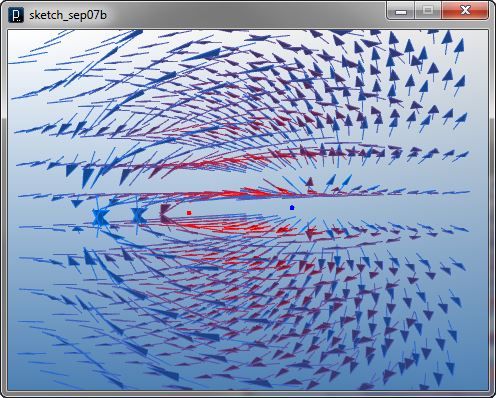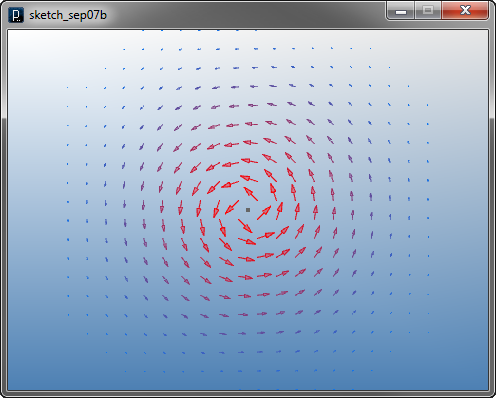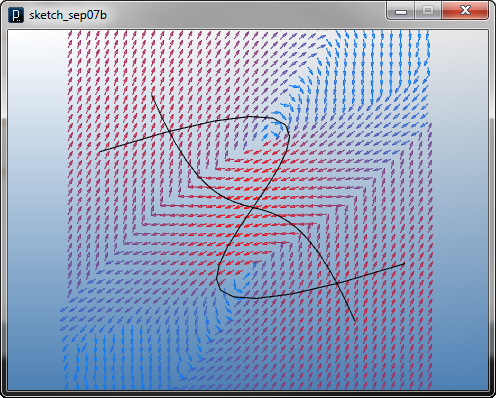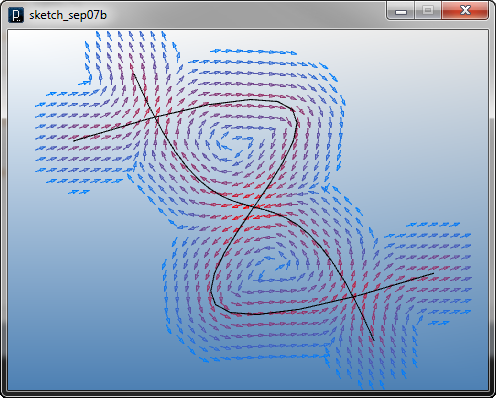

 Tutorials Tutorials | (back to the list of tutorials) |
 Simple Field: Gravity and Attractor
Simple Field: Gravity and Attractor

An attractor and a repulsion force defines a 3D vector force towards the position of attractor/repulsion from the position of a particle.

Besides creating gravity and a attractor in previous example codes, iGeo library has a class of gravity, IGravity and a class of attractor IAttractor as a type of generic fields. The example below shows a code to use IGravity class. You can specify the gravity vector by x, y and z in the constructor. This code also use a type of a particle class IParticleTrajectory, which creates trajectory lines of the particle.
![]()
![]()
![]()
![]()
import processing.opengl.*;
import igeo.*;
size(480, 360, IG.GL);
IG.duration(50);
new IGravity(0,0,-10); // direction and intensity of gravity
for(int i=0; i < 100; i++){
new IParticleTrajectory(IRand.pt(-100,100));// random points from (-100,-100,-100) to (100,100,100)
}

The code below is an example of IAttractor. You can specify the position of attractor in the constructor and the intensity of the attractor by intensity(double) method. If you put negative number in the intensity, it provides a repulsion force instead of an attraction force.
![]()
![]()
![]()
![]()
import processing.opengl.*;
import igeo.*;
size(480, 360, IG.GL);
IG.duration(100);
new IAttractor(0,0,0).intensity(10); // attractor at (0,0,0) with intensity 10
for(int i=0; i < 100; i++){
new IParticleTrajectory(IRand.pt(-100,100));// random points from (-100,-100,-100) to (100,100,100)
}

 Visualizing Field
Visualizing Field


Because the output vectors can vary at different positions, you'd want to sample the output at many positions to comprehend the whole field. iGeo library has a class of IFieldVisualizer to have a 3D matrix of sampled vectors to visualize fields. To use IFieldVisualizer, you specify x, y, z coordinates of two corners for a 3D matrix to sample vectors. As default it creates 10x10x10 matrix within the specified bounding box.
![]()
![]()
![]()
![]()
import processing.opengl.*; import igeo.*; size(480, 360, IG.GL); new IAttractor(-50,0,0).intensity(10).clr(1.0,0,0);//attractor new IAttractor(50,0,0).intensity(-10).clr(0,0,1.0);//repulsion // creating 3D matrix. default is 10x10x10. // input argument is (minX, minY, minZ, maxX, maxY, maxZ) new IFieldVisualizer(-100,-100,-100,100,100,100);

You can show only 2D vector field by putting same z coordinates for the bounding box and specifying sample number in z to be 1.
![]()
![]()
![]()
![]()
import processing.opengl.*; import igeo.*; size(480, 360, IG.GL); new IAttractor(-50,0,0).intensity(10).clr(1.0,0,0);//attractor new IAttractor(50,0,0).intensity(-10).clr(0,0,1.0);//repulsion // last 3 inputs are sample number in x, y, z. new IFieldVisualizer(-100, -50, 0, 100, 50, 0, 40, 20, 1);

You can also change min/max colors to show the intensity by the method colorRange(min red, min green, min blue, max red, max green, max blue). Although the length of sampled vector is all same as default, you can change it to be proportional to the intensity of the field by putting false to the method fixLength(boolean).
![]()
![]()
![]()
![]()
import processing.opengl.*; import igeo.*; size(480, 360, IG.GL); new IAttractor(-50,0,0).intensity(10).clr(1.0,0,0);//attractor new IAttractor(50,0,0).intensity(-10).clr(0,0,1.0);//repulsion IFieldVisualizer visualizer = new IFieldVisualizer(-100, -50, 0, 100, 50, 0, 40, 20, 1); // color of min/max intensty. inputs are (min red, green, blue, max red, green, blue) visualizer.colorRange(0.0,0.0,0.0, 0.0,1.0,0.); // use variable length; now length is proportioanl to the intensity visualizer.fixLength(false);

 Decay of Field from Defining Geometry
Decay of Field from Defining GeometryNo decay provides constant intensity. This is a default decay type of most of fields class in the library. You can also specify this type by noDecay() method.

![]()
![]()
![]()
![]()
import processing.opengl.*; import igeo.*; size(480, 360, IG.GL); new IAttractor(0,0,0).noDecay(); new IFieldVisualizer(-100,-100,0,100,100,0,20,20,1).fixLength(false);

The second decay type is linear decay. This type is specified with a parameter of threshold. When the distance from the geometry is equal to the threshold, the intensity becomes zero. You can specify this type by linearDecay(threshold). There is also an alias of this method linear(threshold).

![]()
![]()
![]()
![]()
import processing.opengl.*; import igeo.*; size(480, 360, IG.GL); new IAttractor(0,0,0).linearDecay(100); new IFieldVisualizer(-100,-100,0,100,100,0,20,20,1).fixLength(false);

The third decay type is Gaussian decay. This type is specified with a parameter of threshold as well. The intensity follows the Gaussian function and the threshold is equal to double of the standard deviation. Even when the distance is larger than the threshold, the intensity doesn't become zero but gradually gets closer to zero. You can specify this type by gaussianDecay(threshold). There is also an alias of this method gaussian(threshold).

![]()
![]()
![]()
![]()
import processing.opengl.*; import igeo.*; size(480, 360, IG.GL); new IAttractor(0,0,0).gaussianDecay(100); new IFieldVisualizer(-100,-100,0,100,100,0,20,20,1).fixLength(false);

 Field Defined by Points
Field Defined by Points ![]()
![]()
![]()
![]()
import processing.opengl.*; import igeo.*; size(480, 360, IG.GL); new IPointCurlField(new IVec(0,0,0), new IVec(0,0,1)).gaussianDecay(100); new IFieldVisualizer(-100,-100,0,100,100,0,20,20,1).fixLength(false);

 Field Defined by Curves (Attractor, Tangent, Curl)
Field Defined by Curves (Attractor, Tangent, Curl)First, a curve attractor field attracts a particle to the closest point on the curve. The class in the library is ICurveAttractorField. You put one curve as an input to build the curve attractor. The curve attractor field is visualized below.
The sample input file used below is this file.
curve_field1.3dm
![]()
![]()
![]()
![]()
import processing.opengl.*;
import igeo.*;
size(480, 360, IG.GL);
IG.open("curve_field1.3dm");
for(int i=0; i < IG.curveNum(); i++){
new ICurveAttractorField(IG.curve(i)).intensity(10).linear(50);
}
new IFieldVisualizer(-20,-20,0, 20,20,0, 40,40,1);

The code below shows the response of particles to the curve attractor fields with trajectory lines.
![]()
![]()
![]()
![]()
import processing.opengl.*;
import igeo.*;
size(480, 360, IG.GL);
IG.darkBG();
IG.open("curve_field1.3dm");
for(int i=0; i < IG.curveNum(); i++){
new ICurveAttractorField(IG.curve(i)).intensity(10).linear(50);
}
new IFieldVisualizer(-20,-20,0, 20,20,0, 40,40,1);
for(int i=0; i < 1000; i++){
new IParticleTrajectory(IRand.pt(-20,-20,20,20)).fric(0.1).clr(1.0,0.7);
}

The second curve field is a curve tangent field. This field defines a force towards the direction of a tangent vector of the curve at the closest point from the given particle position. The class of this type of field is ICurveTangentField. The field is visualized below.
![]()
![]()
![]()
![]()
import processing.opengl.*;
import igeo.*;
size(480, 360, IG.GL);
IG.open("curve_field1.3dm");
for(int i=0; i < IG.curveNum(); i++){
new ICurveTangentField(IG.curve(i)).intensity(10).linear(50);
}
new IFieldVisualizer(-20,-20,0, 20,20,0, 40,40,1);

The below example is to show the response of particles to the field.
![]()
![]()
![]()
![]()
import processing.opengl.*;
import igeo.*;
size(480, 360, IG.GL);
IG.darkBG();
IG.open("curve_field1.3dm");
for(int i=0; i < IG.curveNum(); i++){
new ICurveTangentField(IG.curve(i)).intensity(10).linear(50);
}
new IFieldVisualizer(-20,-20,0, 20,20,0, 40,40,1);
for(int i=0; i < 1000; i++){
new IParticleTrajectory(IRand.pt(-20,-20,20,20)).fric(0.1).clr(1.0,0.7);
}

The third curve field is a curve curl field. This defines a force by a cross vector of a tangent vector on the curve and the difference vector from the closest point on the curve to the given position of a particle. As result, the force is always perpendicular to the tangent and the particle shows a curling behavior. The class of this field is ICurveCurlField. The below shows visualization of the field.
![]()
![]()
![]()
![]()
import processing.opengl.*;
import igeo.*;
size(480, 360, IG.GL);
IG.open("curve_field1.3dm");
for(int i=0; i < IG.curveNum(); i++){
new ICurveCurlField(IG.curve(i)).intensity(10).linear(50);
}
new IFieldVisualizer(-20,-20,-1, 20,20,1, 40,40,2);

The example blow shows the response of particles to the field.
![]()
![]()
![]()
![]()
import processing.opengl.*;
import igeo.*;
size(480, 360, IG.GL);
IG.darkBG();
IG.open("curve_field1.3dm");
for(int i=0; i < IG.curveNum(); i++){
new ICurveCurlField(IG.curve(i)).intensity(10).linear(50);
}
new IFieldVisualizer(-20,-20,-1, 20,20,1, 40,40,2);
for(int i=0; i < 1000; i++){
new IParticleTrajectory(IRand.pt(-20,-20,20,20)).fric(0.1).clr(1.0,0.7);
}

 Multiple Summed Fields
Multiple Summed Fields
The sample input file of multiple curves used below is this file.
curve_field2.3dm
![]()
![]()
![]()
![]()
import processing.opengl.*;
import igeo.*;
size(480, 360, IG.GL);
IG.open("curve_field2.3dm");
for(int i=0; i < IG.curveNum(); i++){
new ICurveTangentField(IG.curve(i)).intensity(10).linear(50);
}
new IFieldVisualizer(-20,-20,0, 20,20,0, 40,40,1);

![]()
![]()
![]()
![]()
import processing.opengl.*;
import igeo.*;
size(480, 360, IG.GL);
IG.darkBG();
IG.open("curve_field2.3dm");
for(int i=0; i < IG.curveNum(); i++){
new ICurveTangentField(IG.curve(i)).intensity(10).linear(50);
}
new IFieldVisualizer(-20,-20,0, 20,20,0, 40,40,1);
for(int i=0; i < 1000; i++){
new IParticleTrajectory(IRand.pt(-20,-20,20,20)).fric(0.1).clr(1.0,0.7);
}

Vector summation of multiple fields sometimes changes the behavior drastically especially when fields have no decay, because some local area responding to an adjacent source curve is equally influenced by other source curves in farther location. Another pair of examples below shows when you limit the influence by putting a smaller threshold.
![]()
![]()
![]()
![]()
import processing.opengl.*;
import igeo.*;
size(480, 360, IG.GL);
IG.open("curve_field2.3dm");
for(int i=0; i < IG.curveNum(); i++){
new ICurveTangentField(IG.curve(i)).linear(5).intensity(10);
}
new IFieldVisualizer(-20,-20,0, 20,20,0, 40,40,1);

![]()
![]()
![]()
![]()
import processing.opengl.*;
import igeo.*;
size(480, 360, IG.GL);
IG.darkBG();
IG.open("curve_field2.3dm");
for(int i=0; i < IG.curveNum(); i++){
new ICurveTangentField(IG.curve(i)).linear(5).intensity(10);
}
new IFieldVisualizer(-20,-20,0, 20,20,0, 40,40,1);
for(int i=0; i < 1000; i++){
new IParticleTrajectory(IRand.pt(-20,-20,20,20)).fric(0.1).clr(1.0,0.7);
}

 Compound Field
Compound Field The code below is a example of a compound field. To add a field as a member of compound field, you use add( field ).
![]()
![]()
![]()
![]()
import processing.opengl.*;
import igeo.*;
size(480, 360, IG.GL);
IG.open("curve_field2.3dm");
ICompoundField field = new ICompoundField();
for(int i=0; i < IG.curveNum(); i++){
field.add(new ICurveTangentField(IG.curve(i)).linear(50).intensity(10));
}
new IFieldVisualizer(-20,-20,0, 20,20,0, 40,40,1);

![]()
![]()
![]()
![]()
import processing.opengl.*;
import igeo.*;
size(480, 360, IG.GL);
IG.darkBG();
IG.open("curve_field2.3dm");
ICompoundField field = new ICompoundField();
for(int i=0; i < IG.curveNum(); i++){
field.add(new ICurveTangentField(IG.curve(i)).linear(50).intensity(10));
}
new IFieldVisualizer(-20,-20,0, 20,20,0, 40,40,1);
for(int i=0; i < 1000; i++){
new IParticleTrajectory(IRand.pt(-20,-20,20,20)).fric(0.1).clr(1.0,0.7);
}

A gravity field doesn't have a source geometry as mentioned above because
gravity generates a constant force everywhere.
However, you can specify a point as a source geometry to create
a compound field. If you feed
a position vector and the gravity direction vector to
the constructor
The code below shows an example of construction of a compound field out of multiple gravity fields.
![]()
![]()
![]()
![]()
import processing.opengl.*;
import igeo.*;
size(480, 360, IG.GL);
ICompoundField field = new ICompoundField();
for(int i=0; i < 30; i++){
IVec dir = IRand.pt(-1,-1,1,1);
IVec pos = IRand.pt(-20,-20,20,20);
field.add(new IGravity(pos, dir));
}
new IFieldVisualizer(-20,-20,0, 20,20,0, 40,40,1);

![]()
![]()
![]()
![]()
import processing.opengl.*;
import igeo.*;
size(480, 360, IG.GL);
IG.darkBG();
ICompoundField field = new ICompoundField();
for(int i=0; i < 30; i++){
IVec dir = IRand.pt(-1,-1,1,1);
IVec pos = IRand.pt(-20,-20,20,20);
field.add(new IGravity(pos, dir));
}
new IFieldVisualizer(-20,-20,0, 20,20,0, 40,40,1);
for(int i=0; i < 2000; i++){
new IParticleTrajectory(IRand.pt(-20,-20,20,20)).fric(0.1).clr(1.0,0.7);
}

Another example of a compound field is with multiple IPointCurlField.
![]()
![]()
![]()
![]()
import processing.opengl.*;
import igeo.*;
size(480, 360, IG.GL);
IG.darkBG();
ICompoundField field = new ICompoundField();
for(int i=0; i < 30; i++){
field.add(new IPointCurlField(IRand.pt(-20,-20,20,20), new IVec(0,0,1)).gaussian(10));
}
new IFieldVisualizer(-20,-20,0, 20,20,0, 40,40,1);
for(int i=0; i < 2000; i++){
new IParticleTrajectory(IRand.pt(-20,-20,20,20)).fric(0.1).clr(1.0,0.7);
}

Or you can mix different types of fields together randomly with a probability switch IRand.pct(percent).
![]()
![]()
![]()
![]()
import processing.opengl.*;
import igeo.*;
size(480, 360, IG.GL);
IG.darkBG();
ICompoundField field = new ICompoundField();
for(int i=0; i < 30; i++){
if(IRand.pct(40)){
field.add(new IAttractor(IRand.pt(-20,-20,20,20)).intensity(-10).gaussian(20));
}
else if(IRand.pct(50)){
field.add(new IPointCurlField(IRand.pt(-20,-20,20,20), new IVec(0,0,1)));
}
else{
field.add(new IGravity(IRand.pt(-20,-20,20,20),IRand.pt(-1,-1,1,1)));
}
}
new IFieldVisualizer(-20,-20,0, 20,20,0, 40,40,1);
for(int i=0; i < 2000; i++){
new IParticleTrajectory(IRand.pt(-20,-20,20,20)).fric(0.1).clr(1.0,0.7);
}

 Field Defined by Surfaces (Tangent, Normal, Slope)
Field Defined by Surfaces (Tangent, Normal, Slope)The sample code below shows a surface tangent field of ISurfaceUTangentField. This field generates forces towards the U tangent vectors of the surface.
The sample surface file used below is this file.
surface_field1.3dm
![]()
![]()
![]()
![]()
import processing.opengl.*;
import igeo.*;
size(480, 360, IG.GL);
IG.open("surface_field1.3dm");
for(int i=0; i < IG.surfaceNum(); i++){
new ISurfaceUTangentField(IG.surface(i)).linear(50).intensity(10);
}
new IFieldVisualizer(-20,-20,-2, 20,20,0, 20,20,2);

![]()
![]()
![]()
![]()
import processing.opengl.*;
import igeo.*;
size(480, 360, IG.GL);
IG.darkBG();
IG.open("surface_field1.3dm");
for(int i=0; i < IG.surfaceNum(); i++){
new ISurfaceUTangentField(IG.surface(i)).linear(50).intensity(10);
}
new IFieldVisualizer(-20,-20,-2, 20,20,0, 20,20,2);
for(int i=0; i < 1000; i++){
new IParticleTrajectory(IRand.pt(-20,-20,-5,20,20,0)).fric(0.1).clr(1.0,0.7);
}

The code below shows another surface tangent field in V direction using ISurfaceVTangentField class.
![]()
![]()
![]()
![]()
import processing.opengl.*;
import igeo.*;
size(480, 360, IG.GL);
IG.darkBG();
IG.open("surface_field1.3dm");
for(int i=0; i < IG.surfaceNum(); i++){
new ISurfaceVTangentField(IG.surface(i)).linear(50).intensity(10);
}
new IFieldVisualizer(-20,-20,-2, 20,20,0, 20,20,2);
for(int i=0; i < 1000; i++){
new IParticleTrajectory(IRand.pt(-20,-20,-5,20,20,0)).fric(0.1).clr(1.0,0.7);
}

The next surface field is a surface normal field of ISurfaceNormalField, which generates forces in the direction of surface normal vectors.
![]()
![]()
![]()
![]()
import processing.opengl.*;
import igeo.*;
size(480, 360, IG.GL);
IG.darkBG();
IG.open("surface_field1.3dm");
for(int i=0; i < IG.surfaceNum(); i++){
new ISurfaceNormalField(IG.surface(i)).linear(50).intensity(10);
}
new IFieldVisualizer(-20,-20,-2, 20,20,0, 20,20,2);
for(int i=0; i < 1000; i++){
new IParticleTrajectory(IRand.pt(-20,-20,-5,20,20,0)).fric(0.1).clr(1.0,0.7);
}

Another surface field is a surface slope field of I2DSurfaceSlopeField, which generates 2D vector only in XY direction (no force in Z direction) by the slope of a surface. If the surface has a valley in Z direction, that part acts as attractor and a hill causes a repulsion force.
![]()
![]()
![]()
![]()
import processing.opengl.*;
import igeo.*;
size(480, 360, IG.GL);
IG.open("surface_field1.3dm");
for(int i=0; i < IG.surfaceNum(); i++){
new I2DSurfaceSlopeField(IG.surface(i)).linear(50).intensity(10);
}
new IFieldVisualizer(-20,-20,0, 20,20,0, 40,40,1);

![]()
![]()
![]()
![]()
import processing.opengl.*;
import igeo.*;
size(480, 360, IG.GL);
IG.darkBG();
IG.open("surface_field1.3dm");
for(int i=0; i < IG.surfaceNum(); i++){
new I2DSurfaceSlopeField(IG.surface(i)).linear(50).intensity(10);
}
new IFieldVisualizer(-20,-20,0, 20,20,0, 40,40,1);
for(int i=0; i < 2000; i++){
new IParticleTrajectory(IRand.pt(-20,-20,20,20)).fric(0.1).clr(1.0,0.7);
}

 Initialize Particles with Points
Initialize Particles with Points
The sample file of curves and points used below is this file.
curve_field_init1.3dm
![]()
![]()
![]()
![]()
import processing.opengl.*;
import igeo.*;
size(480, 360, IG.GL);
IG.darkBG();
IG.open("curve_field_init1.3dm");
ICurve[] fieldCurves = IG.layer("field").curves();
for(int i=0; i < fieldCurves.length; i++){
new ICurveTangentField(fieldCurves[i]).linear(20).intensity(50);
}
IPoint[] points = IG.layer("particle").points();
for(int i=0; i < points.length; i++){
new IParticleTrajectory(points[i]).fric(0.2).clr(points[i].clr());
points[i].del();
}
The following is the initial location of points specified in the rhino file.


 Initialize Particles with Points on Curves
Initialize Particles with Points on Curves
The sample file of curves used below is this file.
The curves for field and particle are stored in different layers.
curve_field_init2.3dm
![]()
![]()
![]()
![]()
import processing.opengl.*;
import igeo.*;
size(480, 360, IG.GL);
IG.darkBG();
IG.open("curve_field_init2.3dm");
ICurve[] fieldCurves = IG.layer("field").curves();
for(int i=0; i < fieldCurves.length; i++){
new ICurveTangentField(fieldCurves[i]).linear(20).intensity(50);
}
int divisionNum = 50;
ICurve[] particleCurves = IG.layer("particle").curves();
for(int i=0; i < particleCurves.length; i++){
for(int j=0; j < divisionNum; j++){
IVec pos = particleCurves[i].pt( 1.0/divisionNum*j );
new IParticleTrajectory(pos).fric(0.2).clr(particleCurves[i].clr());
}
}


 Initialize Particles with Surfaces and Meshes
Initialize Particles with Surfaces and MeshesThe following is the example code to create particle (IParticleTrajectory) with input geometries in a specific layer in a input 3dm file. This code extracts instances of IGeometry from the specified layer in the internal server. IGeometry is a super class of IPoint, ICurve, ISurface, IMesh and IBrep. The method IG.geometries() or IG.layer(layerName).geometries() returns all geometries inside the internal server or inside the specified layer. The return value is an array containing any type of geometry and it can be mixture of different types if any.
The sample file of curves used below is this file.
curve_field_init3.3dm
![]()
![]()
![]()
![]()
import processing.opengl.*;
import igeo.*;
size(480, 360, IG.GL);
IG.duration(250);
IG.darkBG();
IG.open("curve_field_init3.3dm");
ICurve[] fieldCurves = IG.layer("field").curves();
for(int i=0; i < fieldCurves.length; i++){
new ICurveTangentField(fieldCurves[i]).linear(20).intensity(50);
}
IGeometry[] geometries = IG.layer("particle").geometries(); // all geometries in "particle" layer
for(int i=0; i < geometries.length; i++){
new IParticleTrajectory(geometries[i]).fric(0.2); // create a particle out of each geometry
}
The image below shows the initial geometries from the input file.

Each input geometry is moved and rotated as a particle by the force field.


Another example below shows a code to convert input geometries into swarm agent (IBoid instance) to distribute geometries under the surface field condition and the swarming logic.
The sample file of curves used below is this file.
curve_field_init4.3dm
![]()
![]()
![]()
![]()
import processing.opengl.*;
import igeo.*;
size(480, 360, IG.GL);
IG.darkBG();
IG.duration(700);
IG.open("curve_field_init4.3dm");
ISurface[] fieldSurfaces = IG.layer("field").surfaces();
for(int i=0; i < fieldSurfaces.length; i++){
new I2DSurfaceSlopeField(fieldSurfaces[i]).linear(50).intensity(10);
}
new IFieldVisualizer(-20,-20,0, 20,20,0, 40,40,1);
IGeometry[] geometries = IG.layer("particle").geometries();
for(int i=0; i < geometries.length; i++){
IBoid b = new IBoid(geometries[i]).fric(0.2);
b.cohesionRatio(5.0);
b.cohesionDist(5.5);
b.separationRatio(25.0);
b.separationDist(5.0);
b.alignmentRatio(15.0);
b.alignmentDist(7.0);
}
Initial state.

Distribution under the surface field condition and the swarming logic. Geometries loosely gather around the valley areas of the field surface but keeping distance to other geometries by the swarm algorithm.

 HOME
HOME
 FOR PROCESSING
FOR PROCESSING
 DOWNLOAD
DOWNLOAD
 DOCUMENTS
DOCUMENTS
 TUTORIALS (Java /
Python)
TUTORIALS (Java /
Python)
 GALLERY
GALLERY
 SOURCE CODE(GitHub)
SOURCE CODE(GitHub)
 PRIVACY POLICY
PRIVACY POLICY
 ABOUT/CONTACT
ABOUT/CONTACT
